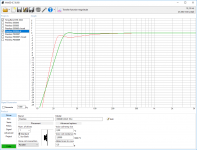Hello! I'm in doubt using WinISD about its "signal" feature. I modeled two sub projects, one really built, called system "OLD", and one I would want to build, called system "NEW".
OLD is based on one 10'' dual voice coil XXLS Peerless for vented system (830846) in 64 liters tuned at 28 Hz through an exponential vent, wonderful sub:
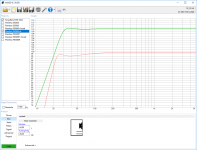
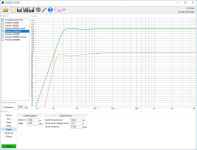
NEW is based on a couple of 8'' Tang Band W8-2022 used in push-pull in 28 liters tuned at 23 Hz through a 10'' passive radiator with 300 grams added mass:
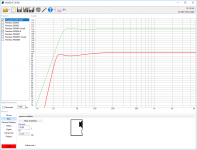
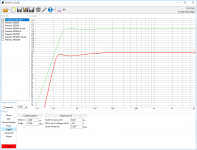
As you can see there's an enormous difference in SPL so I need to understand about signal input value: 200 watts I entered are those provided by amplifier or those taken by drivers? And in a push-pull as NEW, taken by each driver or by both?
Given that OLD has 1 driver with 2 x 8 ohms voice coils in parallel for a total of 4 ohms and NEW has 2 drivers with 1 x 8 ohm voice coil for each which forms in parallel a total of 4 ohms too, why I see 22.8 volts for OLD and 36.3 volts for NEW, even having both the same final total nominal impedance?
I don't understand if I'm going wrong with these numbers in my simulation, given the big difference between systems.
Thank you very much.
OLD is based on one 10'' dual voice coil XXLS Peerless for vented system (830846) in 64 liters tuned at 28 Hz through an exponential vent, wonderful sub:


NEW is based on a couple of 8'' Tang Band W8-2022 used in push-pull in 28 liters tuned at 23 Hz through a 10'' passive radiator with 300 grams added mass:


As you can see there's an enormous difference in SPL so I need to understand about signal input value: 200 watts I entered are those provided by amplifier or those taken by drivers? And in a push-pull as NEW, taken by each driver or by both?
Given that OLD has 1 driver with 2 x 8 ohms voice coils in parallel for a total of 4 ohms and NEW has 2 drivers with 1 x 8 ohm voice coil for each which forms in parallel a total of 4 ohms too, why I see 22.8 volts for OLD and 36.3 volts for NEW, even having both the same final total nominal impedance?
I don't understand if I'm going wrong with these numbers in my simulation, given the big difference between systems.
Thank you very much.
addendum: take a look at Transfer Function Magnitude, where responses overlapses
View attachment 716885
What does it mean? Really will my push-pull NEW be so poor in SPL? I know that Tang Band I would use aren't really efficient but not imagined so..
View attachment 716885
What does it mean? Really will my push-pull NEW be so poor in SPL? I know that Tang Band I would use aren't really efficient but not imagined so..
WinISD does its calculations assuming an amplifier with a certain output voltage. The voltage is calculated from the nominal input power and dc resistance of the woofer: voltage = sqrt(power * resistance). How much power is really taken by the woofer does not only depend on voltage, but also depends on the woofer impedance and impedance phase.
The nominal input power itself does not really have a meaning, besides corresponding to a voltage.
A Peerless 830843 does 87 dB on 1 nominal watt* so should do 110 dB on 200 watts. https://audio-hi.fi/download/pdf/Peerless_XXLS10_P830843_subwoofer.pdf
For the Tang Band W8-2022 it's 83 and 106 dB respectively. A difference of -4 dB as compared to the Peerless. https://www.parts-express.com/pedocs/specs/264-955s.pdf
Your Peerless simulations seems to be right, the Tang Band should be louder. A possible cause is that there might be a typo in the driver parameters as entered in WinISD.
*Again a voltage. Manufacturers typically use voltage = sqrt(power * nominal impedance), which is slightly different from the definition of WinISD.
The nominal input power itself does not really have a meaning, besides corresponding to a voltage.
A Peerless 830843 does 87 dB on 1 nominal watt* so should do 110 dB on 200 watts. https://audio-hi.fi/download/pdf/Peerless_XXLS10_P830843_subwoofer.pdf
For the Tang Band W8-2022 it's 83 and 106 dB respectively. A difference of -4 dB as compared to the Peerless. https://www.parts-express.com/pedocs/specs/264-955s.pdf
Your Peerless simulations seems to be right, the Tang Band should be louder. A possible cause is that there might be a typo in the driver parameters as entered in WinISD.
*Again a voltage. Manufacturers typically use voltage = sqrt(power * nominal impedance), which is slightly different from the definition of WinISD.
Last edited:
Ok thank you, but fact that WinISD visualizes a bigger voltage for NEW push-pull system (2 x 8 0hm drivers in parallel) than OLD system (2 x 8 ohm voice coil in parallel) signifies that it's applying 200 W power to one driver only (8 ohm). May this be the cause of excessive low SPL graph? It's true that one of two drivers of NEW won't emit any SPL being in the rear side of cabinet..I'm confused..: (
Andrea,
If you mean push-pull as in Isobaric, remember that this reduces the overall sensitivity of the system compared with a single driver, as opposed to increasing it like a normal dual driver setup.
This does buy you the benefit of getting to a lower frequency in a much smaller box, so it's just a case of weighing up which compromises you want to make.
HTH,
David.
If you mean push-pull as in Isobaric, remember that this reduces the overall sensitivity of the system compared with a single driver, as opposed to increasing it like a normal dual driver setup.
This does buy you the benefit of getting to a lower frequency in a much smaller box, so it's just a case of weighing up which compromises you want to make.
HTH,
David.
how does putting a driver on the rear of the cabinet stop it from emitting spl?
is driver polarity the issue here?
No no I mean that I'm asking if WinISD may consider null the SPL coming from one driver because of its being internal in a psh-pull configuration.. I was just wondering this.
Andrea,
If you mean push-pull as in Isobaric, remember that this reduces the overall sensitivity of the system compared with a single driver, as opposed to increasing it like a normal dual driver setup.
Yes I know, but I didn't expect such a big difference.. I've thought a loss of -4 dB due the lower efficiency of Tang Bands and -3 dB due to push-pull isobaric, for a total of -7 dB, not such a big difference of -12 dB!
Yes I know, but I didn't expect such a big difference.. I've thought a loss of -4 dB due the lower efficiency of Tang Bands and -3 dB due to push-pull isobaric, for a total of -7 dB, not such a big difference of -12 dB!
OK, had a look at this a bit further, and I think that WinISD is calculating a bigger loss of efficiency for the Isobaric loading than expected.
As you've said, we expect 3dB loss of efficiency from the Isobaric loading, but if you compare a single driver with the Isobaric pair WinISD is showing it to be 6dB less efficient.
What you could do is enter a custom version of your driver's TS parameters to represent the Isobaric pair as one unit instead: you would double Mms & power handling, and halve Cms & Re, leaving all the others the same as for a single unit.
That seems to give results more in line with expectations.
- Status
- This old topic is closed. If you want to reopen this topic, contact a moderator using the "Report Post" button.
- Home
- Loudspeakers
- Subwoofers
- Using Signal value in WINISD
